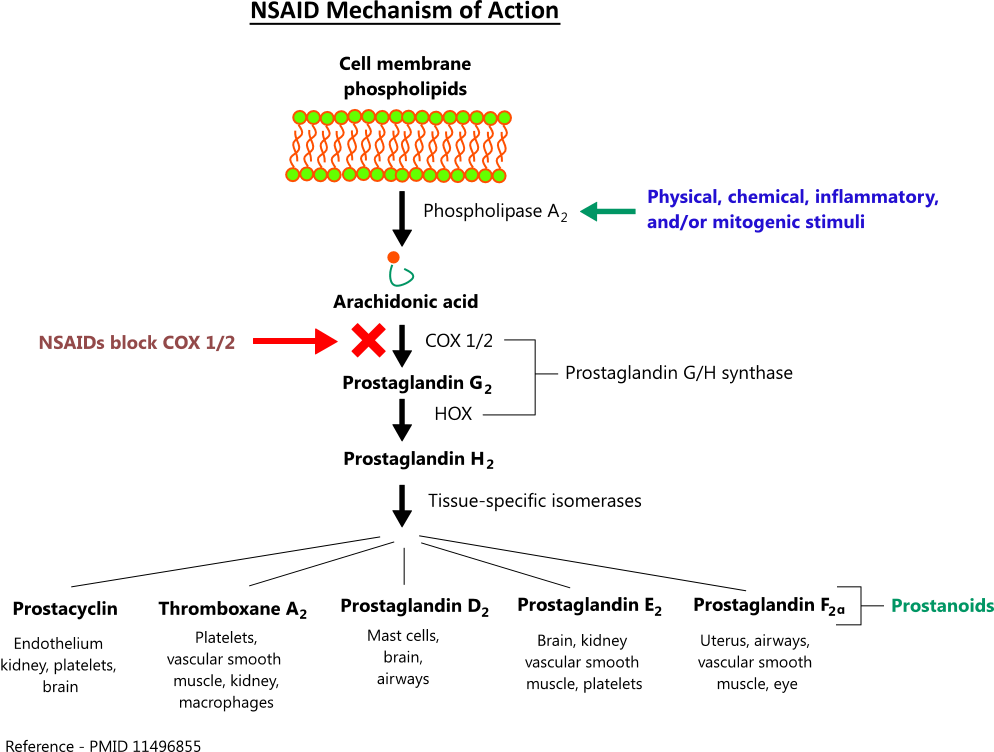
- Diclofenac is commonly used NSAIDs (Non-steroidal anti-inflammatory drugs). Chemically it is heterocyclic arylacetic derivatives.
- It is very old drug which came into medical use in 1988. It is also available as generic medicine nowadays.
Indications of diclofenac
- Used in treating pain resulting from minor surgery, trauma and dysmenorrhea.
- Used in long-term symptomatic treatment of rheumatoid arthritis, osteoarthritis and ankylosing spondylitis.
- Ophthalmic solution is available for treating post- operative inflammation following cataract extraction, pain in eye and photophobia.
- It is used in combination with misoprostol as a gastro protective agent in patients with high risk of developing NSAIDs induced ulcer.
Mechanism of action of diclofenac

Figure- Mechanism of action of NSAIDs including diclofenac. (Reference- PMID 11496855).
- Its mechanism of action is similar as of other NSAIDs. During pain, fever and inflammation arachidonic acid is liberated from phospholipid fraction of cell membrane by phospholipase A2. Arachidonic acid is converted to prostaglandins (PGs) by cyclooxygenase (COX-1 and COX-2).
- The prostaglandins produced sensitize blood vessels to other inflammatory mediators which increase permeability and sensitize chemical receptor of afferent pain ending to mediators such as histamine and bradykinin. PGE2 and PGI2 produce hyperalgesia associated with inflammation. They are also involved in pyretic response. Diclofenac inhibits both COX-1 and COX-2 enzymes and hence inhibit production of prostaglandins resulting in its analgesic and anti-inflammatory actions. It inhibits COX-1 and COX-2 with equal affinity. However, there are some studies which suggest its selective COX-2 inhibition. The selectivity of diclofenac for COX-2 is like that of celecoxib.
- Its peripheral analgesic effect is due to its ability to decrease availability of peripheral pain receptors by downregulating them which occurs as a result of stimulation of L-arginine nitric oxide cGMP pathway by activation of ATP sensitive potassium channels. Some studies also suggest that diclofenac is able to decrease increased level of substance P- a proinflammatory neuropeptide.
Pharmacokinetics
- It is available as salt of sodium, potassium or epolamine. Diclofenac sodium is administered through oral route as tablet and suspension, IM, IV, transdermal or rectal route. Diclofenac potassium is available for oral administration in form of tablet and suspension and diclofenac epolamine is available as transdermal patch. It is available in both immediate release and extended release form. When administered through oral route, it undergoes first pass metabolism. It accumulates in synovial fluid after oral administration.
- It extensively binds to plasma proteins (around 99%). Metabolism takes place in liver and excreted via urine and bile. The main metabolite is 4- hydroxy derivative of diclofenac sodium.
- Its plasma half-life is around 2 hours. Its concentration in synovial fluid is maintained for 3 times long time than in plasma. Hence, it has extended therapeutic action in joints.
Adverse effects
- It produces side effects in around 20% of patients. Around 2% of patients discontinue it due to its adverse effects.
- It produces mild adverse effects like epigastric pain, dizziness and rashes. It may cause GI symptoms like GI bleeding and can cause elevation of liver enzymes. Hence, continuous monitoring of level of liver enzymes should be done during first few weeks of long-term therapy of diclofenac.
- It can cause reduction in renal blood flow, GFR (glomerular filtration rate) and may also cause renal damage rarely. Like other NSAIDs, it increases cardiovascular risks.
Contraindication
- It is contraindicated in pregnant women and nursing mothers.
- Its use is avoided in children.
- Contraindicated in patients with renal disease like diabetic nephropathy.
- Contraindicated in patients with history of increased cardiovascular risk such as stroke or MI (myocardial infarction).
- It is also contraindicated in patients with known hypersensitivity to diclofenac or other NSAIDs.
References
- Brogden et al. Diclofenac Sodium: A Review of its Pharmacological Properties and Therapeutic Use in Rheumatic Diseases and Pain of Varying Origin. Drugs volume. 1980; 20: 24–48.
- Gan TJ. Diclofenac: an update on its mechanism of action and safety profile. 2010; 26(7): 1715-1731.
- https://www.statpearls.com/ArticleLibrary/viewarticle/40763
- https://go.drugbank.com/drugs/DB00586
- Goodman and Gillman’s Manual of Pharmacology.
- Pharmacology and pharmacotherapeutics. 24th edition.
- A Textbook of Clinical Pharmacology and Therapeutics.
- Lippincott Illustrated Reviews Pharmacology, 6th edition.